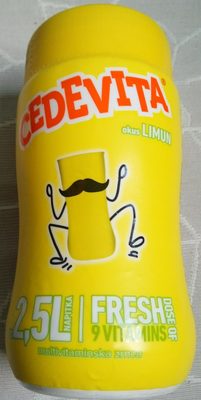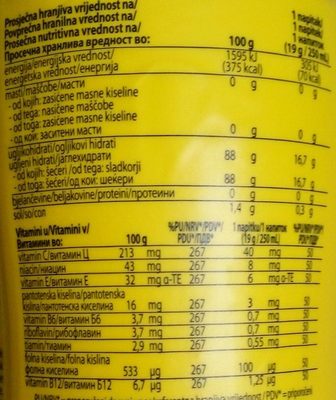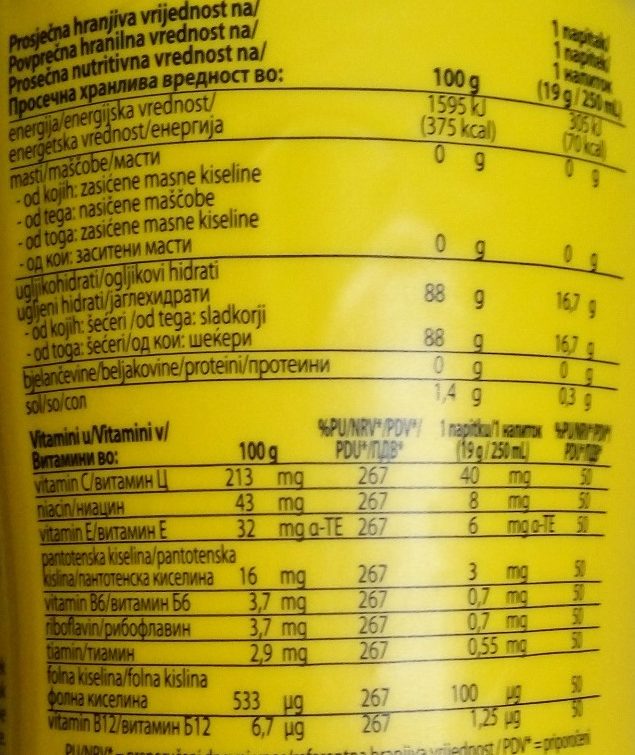Help us make food transparency the norm!
As a non-profit organization, we depend on your donations to continue informing consumers around the world about what they eat.
The food revolution starts with you!
Cedevita ukus limun - 200 g
Cedevita ukus limun - 200 g
This product page is not complete. You can help to complete it by editing it and adding more data from the photos we have, or by taking more photos using the app for Android or iPhone/iPad. Thank you!
×
Barkod: 3850322003534 (EAN / EAN-13)
Common name: multivitaminske granule, dodatak ishrani sa ukusom limuna
Količina: 200 g
Ambalaža: en:Plastic
Брендови: Cedevita
Категорије: en:Beverages, en:Dried products, en:Dried products to be rehydrated, en:Dehydrated beverages
Mesto u kojem se proizvodi ili prerađuje: Croatia
Matching with your preferences
Health
Sastojci
-
16 ingredients
šećer, limunska kiselina, regulator kiselosti: natrijum-hidrogenkarbonat, prirodna aroma limuna, L-askorbinska kiselina, DL-α-tokoferilacetat, nikotinamid, zgušnjivač E414, kalcijum-D-pantotenat, tiamin-mononitrat, natrijum riboflavin-5'-fosfat, pirodoksin-hidrohlorid, cijanokobalamin, pteroilmonoglutaminska kiselina. Boja napitka potiče od vitamina B2.
Food processing
-
Ultra processed foods
Elements that indicate the product is in the en:4 - Ultra processed food and drink products group:
- Адитив: E101
- Адитив: E414
Food products are classified into 4 groups according to their degree of processing:
- Neprerađena ili minimalno prerađena hrana
- Prerađeni kulinarski sastojci
- Prerađena hrana
- Ultra processed foods
The determination of the group is based on the category of the product and on the ingredients it contains.
Адитиви
-
E101
Riboflavin: Riboflavin, also known as vitamin B2, is a vitamin found in food and used as a dietary supplement. Food sources include eggs, green vegetables, milk and other dairy product, meat, mushrooms, and almonds. Some countries require its addition to grains. As a supplement it is used to prevent and treat riboflavin deficiency and prevent migraines. It may be given by mouth or injection.It is nearly always well tolerated. Normal doses are safe during pregnancy. Riboflavin is in the vitamin B group. It is required by the body for cellular respiration.Riboflavin was discovered in 1920, isolated in 1933, and first made in 1935. It is on the World Health Organization's List of Essential Medicines, the most effective and safe medicines needed in a health system. Riboflavin is available as a generic medication and over the counter. In the United States a month of supplements costs less than 25 USD.Source: Wikipedia (Енглески језик)
-
E101i
Riboflavin: Riboflavin, also known as vitamin B2, is a vitamin found in food and used as a dietary supplement. Food sources include eggs, green vegetables, milk and other dairy product, meat, mushrooms, and almonds. Some countries require its addition to grains. As a supplement it is used to prevent and treat riboflavin deficiency and prevent migraines. It may be given by mouth or injection.It is nearly always well tolerated. Normal doses are safe during pregnancy. Riboflavin is in the vitamin B group. It is required by the body for cellular respiration.Riboflavin was discovered in 1920, isolated in 1933, and first made in 1935. It is on the World Health Organization's List of Essential Medicines, the most effective and safe medicines needed in a health system. Riboflavin is available as a generic medication and over the counter. In the United States a month of supplements costs less than 25 USD.Source: Wikipedia (Енглески језик)
-
E414
Gum arabic: Gum arabic, also known as acacia gum, arabic gum, gum acacia, acacia, Senegal gum and Indian gum, and by other names, is a natural gum consisting of the hardened sap of various species of the acacia tree. Originally, gum arabic was collected from Acacia nilotica which was called the "gum arabic tree"; in the present day, gum arabic is collected from acacia species, predominantly Acacia senegal and Vachellia -Acacia- seyal; the term "gum arabic" does not indicate a particular botanical source. In a few cases so‐called "gum arabic" may not even have been collected from Acacia species, but may originate from Combretum, Albizia or some other genus. Producers harvest the gum commercially from wild trees, mostly in Sudan -80%- and throughout the Sahel, from Senegal to Somalia—though it is historically cultivated in Arabia and West Asia. Gum arabic is a complex mixture of glycoproteins and polysaccharides. It is the original source of the sugars arabinose and ribose, both of which were first discovered and isolated from it, and are named after it. Gum arabic is soluble in water. It is edible, and used primarily in the food industry as a stabilizer, with EU E number E414. Gum arabic is a key ingredient in traditional lithography and is used in printing, paint production, glue, cosmetics and various industrial applications, including viscosity control in inks and in textile industries, though less expensive materials compete with it for many of these roles. While gum arabic is now produced throughout the African Sahel, it is still harvested and used in the Middle East.Source: Wikipedia (Енглески језик)
-
E500
Sodium carbonate: Sodium carbonate, Na2CO3, -also known as washing soda, soda ash and soda crystals, and in the monohydrate form as crystal carbonate- is the water-soluble sodium salt of carbonic acid. It most commonly occurs as a crystalline decahydrate, which readily effloresces to form a white powder, the monohydrate. Pure sodium carbonate is a white, odorless powder that is hygroscopic -absorbs moisture from the air-. It has a strongly alkaline taste, and forms a moderately basic solution in water. Sodium carbonate is well known domestically for its everyday use as a water softener. Historically it was extracted from the ashes of plants growing in sodium-rich soils, such as vegetation from the Middle East, kelp from Scotland and seaweed from Spain. Because the ashes of these sodium-rich plants were noticeably different from ashes of timber -used to create potash-, they became known as "soda ash". It is synthetically produced in large quantities from salt -sodium chloride- and limestone by a method known as the Solvay process. The manufacture of glass is one of the most important uses of sodium carbonate. Sodium carbonate acts as a flux for silica, lowering the melting point of the mixture to something achievable without special materials. This "soda glass" is mildly water-soluble, so some calcium carbonate is added to the melt mixture to make the glass produced insoluble. This type of glass is known as soda lime glass: "soda" for the sodium carbonate and "lime" for the calcium carbonate. Soda lime glass has been the most common form of glass for centuries. Sodium carbonate is also used as a relatively strong base in various settings. For example, it is used as a pH regulator to maintain stable alkaline conditions necessary for the action of the majority of photographic film developing agents. It acts as an alkali because when dissolved in water, it dissociates into the weak acid: carbonic acid and the strong alkali: sodium hydroxide. This gives sodium carbonate in solution the ability to attack metals such as aluminium with the release of hydrogen gas.It is a common additive in swimming pools used to raise the pH which can be lowered by chlorine tablets and other additives which contain acids. In cooking, it is sometimes used in place of sodium hydroxide for lyeing, especially with German pretzels and lye rolls. These dishes are treated with a solution of an alkaline substance to change the pH of the surface of the food and improve browning. In taxidermy, sodium carbonate added to boiling water will remove flesh from the bones of animal carcasses for trophy mounting or educational display. In chemistry, it is often used as an electrolyte. Electrolytes are usually salt-based, and sodium carbonate acts as a very good conductor in the process of electrolysis. In addition, unlike chloride ions, which form chlorine gas, carbonate ions are not corrosive to the anodes. It is also used as a primary standard for acid-base titrations because it is solid and air-stable, making it easy to weigh accurately.Source: Wikipedia (Енглески језик)
-
E500ii - Натријум хидрогенкарбонат
Sodium carbonate: Sodium carbonate, Na2CO3, -also known as washing soda, soda ash and soda crystals, and in the monohydrate form as crystal carbonate- is the water-soluble sodium salt of carbonic acid. It most commonly occurs as a crystalline decahydrate, which readily effloresces to form a white powder, the monohydrate. Pure sodium carbonate is a white, odorless powder that is hygroscopic -absorbs moisture from the air-. It has a strongly alkaline taste, and forms a moderately basic solution in water. Sodium carbonate is well known domestically for its everyday use as a water softener. Historically it was extracted from the ashes of plants growing in sodium-rich soils, such as vegetation from the Middle East, kelp from Scotland and seaweed from Spain. Because the ashes of these sodium-rich plants were noticeably different from ashes of timber -used to create potash-, they became known as "soda ash". It is synthetically produced in large quantities from salt -sodium chloride- and limestone by a method known as the Solvay process. The manufacture of glass is one of the most important uses of sodium carbonate. Sodium carbonate acts as a flux for silica, lowering the melting point of the mixture to something achievable without special materials. This "soda glass" is mildly water-soluble, so some calcium carbonate is added to the melt mixture to make the glass produced insoluble. This type of glass is known as soda lime glass: "soda" for the sodium carbonate and "lime" for the calcium carbonate. Soda lime glass has been the most common form of glass for centuries. Sodium carbonate is also used as a relatively strong base in various settings. For example, it is used as a pH regulator to maintain stable alkaline conditions necessary for the action of the majority of photographic film developing agents. It acts as an alkali because when dissolved in water, it dissociates into the weak acid: carbonic acid and the strong alkali: sodium hydroxide. This gives sodium carbonate in solution the ability to attack metals such as aluminium with the release of hydrogen gas.It is a common additive in swimming pools used to raise the pH which can be lowered by chlorine tablets and other additives which contain acids. In cooking, it is sometimes used in place of sodium hydroxide for lyeing, especially with German pretzels and lye rolls. These dishes are treated with a solution of an alkaline substance to change the pH of the surface of the food and improve browning. In taxidermy, sodium carbonate added to boiling water will remove flesh from the bones of animal carcasses for trophy mounting or educational display. In chemistry, it is often used as an electrolyte. Electrolytes are usually salt-based, and sodium carbonate acts as a very good conductor in the process of electrolysis. In addition, unlike chloride ions, which form chlorine gas, carbonate ions are not corrosive to the anodes. It is also used as a primary standard for acid-base titrations because it is solid and air-stable, making it easy to weigh accurately.Source: Wikipedia (Енглески језик)
Ingredients analysis
-
Nepoznata količina palminog ulja
Unrecognized ingredients: en:lemon-acid, en:natural-aroma-of-lemon, en:l-ashrbinic-acid, en:dl-α-tokoferilacetat, en:nicotinemide, en:congestion-e414, en:calcium-d-pantotenat, en:tiamin-mononitrat, en:sodium-riboflavin-5-phosphate, en:pyrodoxin-hydrochloride, en:cyanocobalmine, en:pteroilmonoglutamin-acid, en:beverage-coloring-comes-from-vitamin-b2Some ingredients could not be recognized.
We need your help!
You can help us recognize more ingredients and better analyze the list of ingredients for this product and others:
- Edit this product page to correct spelling mistakes in the ingredients list, and/or to remove ingredients in other languages and sentences that are not related to the ingredients.
- Add new entries, synonyms or translations to our multilingual lists of ingredients, ingredient processing methods, and labels.
If you would like to help, join the #ingredients channel on our Slack discussion space and/or learn about ingredients analysis on our wiki. Thank you!
-
Статус вегана непознат
Unrecognized ingredients: en:lemon-acid, en:natural-aroma-of-lemon, en:l-ashrbinic-acid, en:dl-α-tokoferilacetat, en:nicotinemide, en:congestion-e414, en:calcium-d-pantotenat, en:tiamin-mononitrat, en:sodium-riboflavin-5-phosphate, en:pyrodoxin-hydrochloride, en:cyanocobalmine, en:pteroilmonoglutamin-acid, en:beverage-coloring-comes-from-vitamin-b2Some ingredients could not be recognized.
We need your help!
You can help us recognize more ingredients and better analyze the list of ingredients for this product and others:
- Edit this product page to correct spelling mistakes in the ingredients list, and/or to remove ingredients in other languages and sentences that are not related to the ingredients.
- Add new entries, synonyms or translations to our multilingual lists of ingredients, ingredient processing methods, and labels.
If you would like to help, join the #ingredients channel on our Slack discussion space and/or learn about ingredients analysis on our wiki. Thank you!
-
en:Vegetarian status unknown
Unrecognized ingredients: en:lemon-acid, en:natural-aroma-of-lemon, en:l-ashrbinic-acid, en:dl-α-tokoferilacetat, en:nicotinemide, en:congestion-e414, en:calcium-d-pantotenat, en:tiamin-mononitrat, en:sodium-riboflavin-5-phosphate, en:pyrodoxin-hydrochloride, en:cyanocobalmine, en:pteroilmonoglutamin-acid, en:beverage-coloring-comes-from-vitamin-b2Some ingredients could not be recognized.
We need your help!
You can help us recognize more ingredients and better analyze the list of ingredients for this product and others:
- Edit this product page to correct spelling mistakes in the ingredients list, and/or to remove ingredients in other languages and sentences that are not related to the ingredients.
- Add new entries, synonyms or translations to our multilingual lists of ingredients, ingredient processing methods, and labels.
If you would like to help, join the #ingredients channel on our Slack discussion space and/or learn about ingredients analysis on our wiki. Thank you!
-
Details of the analysis of the ingredients
We need your help!
Some ingredients could not be recognized.
We need your help!
You can help us recognize more ingredients and better analyze the list of ingredients for this product and others:
- Edit this product page to correct spelling mistakes in the ingredients list, and/or to remove ingredients in other languages and sentences that are not related to the ingredients.
- Add new entries, synonyms or translations to our multilingual lists of ingredients, ingredient processing methods, and labels.
If you would like to help, join the #ingredients channel on our Slack discussion space and/or learn about ingredients analysis on our wiki. Thank you!
: sugar, lemon acid, acid regulator (sodium-hydrogen carbonate), natural aroma of lemon, l-ashrbinic acid, dl-α-tokoferilacetat, nicotinemide, congestion e414, calcium-d-pantotenat, tiamin-mononitrat, sodium riboflavin-5'-phosphate, pyrodoxin hydrochloride, cyanocobalmine, pteroilmonoglutamin acid, beverage coloring comes from vitamin b2- sugar -> en:sugar - vegan: yes - vegetarian: yes - ciqual_proxy_food_code: 31016 - percent_min: 6.66666666666667 - percent_max: 100
- lemon acid -> en:lemon-acid - percent_min: 0 - percent_max: 50
- acid regulator -> en:acidity-regulator - percent_min: 0 - percent_max: 33.3333333333333
- sodium-hydrogen carbonate -> en:e500ii - vegan: yes - vegetarian: yes - percent_min: 0 - percent_max: 33.3333333333333
- natural aroma of lemon -> en:natural-aroma-of-lemon - percent_min: 0 - percent_max: 25
- l-ashrbinic acid -> en:l-ashrbinic-acid - percent_min: 0 - percent_max: 20
- dl-α-tokoferilacetat -> en:dl-α-tokoferilacetat - percent_min: 0 - percent_max: 16.6666666666667
- nicotinemide -> en:nicotinemide - percent_min: 0 - percent_max: 14.2857142857143
- congestion e414 -> en:congestion-e414 - percent_min: 0 - percent_max: 12.5
- calcium-d-pantotenat -> en:calcium-d-pantotenat - percent_min: 0 - percent_max: 11.1111111111111
- tiamin-mononitrat -> en:tiamin-mononitrat - percent_min: 0 - percent_max: 10
- sodium riboflavin-5'-phosphate -> en:sodium-riboflavin-5-phosphate - percent_min: 0 - percent_max: 9.09090909090909
- pyrodoxin hydrochloride -> en:pyrodoxin-hydrochloride - percent_min: 0 - percent_max: 8.33333333333333
- cyanocobalmine -> en:cyanocobalmine - percent_min: 0 - percent_max: 7.69230769230769
- pteroilmonoglutamin acid -> en:pteroilmonoglutamin-acid - percent_min: 0 - percent_max: 7.14285714285714
- beverage coloring comes from vitamin b2 -> en:beverage-coloring-comes-from-vitamin-b2 - percent_min: 0 - percent_max: 6.66666666666667
Nutritivne vrednosti
-
Hranljiva vrednost
Hranljiva vrednost As sold
for 100 g / 100 mlAs sold
per serving (19 g)Compared to: en:Dried products to be rehydrated Енергија 1.569 kj
(375 kcal)298 kj
(71 kcal)+45% Масти 0 g 0 g -100% Zasićena mast 0 g 0 g -100% Carbohydrates 88 g 16,7 g +114% Шећер 88 g 16,7 g +707% Fiber ? ? Протеин 0 g 0 g -100% Со 1,4 g 0,266 g -86% Vitamin E 32 mg 6,08 mg Витамин Ц 213 mg 40,5 mg Vitamin B1 (Thiamin) 2,9 mg 0,551 mg Vitamin B2 (Riboflavin) 3,7 mg 0,703 mg Vitamin B3 43 mg 8,17 mg Vitamin B6 3.700 mg 703 mg Folates (total folates) 533 µg 101 µg Vitamin B12 (cobalamin) 6,7 µg 1,27 µg Витамин Б5 (Пантотенска киселина) 16 mg 3,04 mg Fruits‚ vegetables‚ nuts and rapeseed‚ walnut and olive oils (estimate from ingredients list analysis) 0 % 0 %
Environment
-
Eco-Score not computed - Unknown environmental impact
We could not compute the Eco-Score of this product as it is missing some data, could you help complete it?Could you add a precise product category so that we can compute the Eco-Score? Add a category
Ambalaža
-
Packaging with a medium impact
-
Packaging parts
(Plastic)
-
Packaging materials
Material % Packaging weight Packaging weight per 100 g of product Plastic
-
Transportation
-
Origins of ingredients
Missing origins of ingredients information
⚠ ️ The origins of the ingredients of this product are not indicated.
If they are indicated on the packaging, you can modify the product sheet and add them.
If you are the manufacturer of this product, you can send us the information with our free platform for producers.Add the origins of ingredients for this product Add the origins of ingredients for this product
Report a problem
-
Incomplete or incorrect information?
Category, labels, ingredients, allergens, nutritional information, photos etc.
If the information does not match the information on the packaging, please complete or correct it. Open Food Facts is a collaborative database, and every contribution is useful for all.
Data sources
Product added on од openfoodfacts-contributors
Last edit of product page on од inf.
Страницу производа такође уредио bojackhorseman, kiliweb, packbot, yuka.YXJ3RUlxTTZ2ZEFNc3NWbDhFUGs1ZFZhbmJtT2JXK3RNTmN0SVE9PQ.








